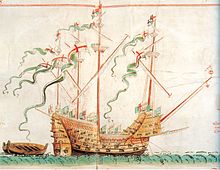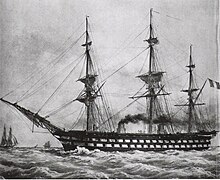Ship of the line
The term "ship of the line" fell into disuse except in historical contexts, after warships and naval tactics evolved and changed from the mid-19th century.[1] The heavily armed carrack, first developed in Spain and Portugal for either trade or war in the Atlantic Ocean, was the precursor of the ship of the line.Contemporary with Mary Rose, Henri Grâce à Dieu was 50 metres (160 ft) long, measuring 1,000–1,500 tons burthen and having a complement of 700–1,000.[citation needed] Mars was likely the largest ship in the world at the time of her build, equipped with 107 guns at a full-length of 96 metres (315 ft).Previously battles had usually been fought by great fleets of ships closing with each other and fighting in whatever arrangement they found themselves in, often boarding enemy vessels as opportunities presented themselves.The most common size of sail ship of the line was the "74" (named for its 74 guns), originally developed by France in the 1730s, and later adopted by all battleship navies.Mahmudiye (1829), ordered by the Ottoman Sultan Mahmud II and built by the Imperial Naval Arsenal on the Golden Horn in Istanbul, was for many years the largest warship in the world.She had vertical sides, which increased significantly the space available for upper batteries, but reduced the stability of the ship; wooden stabilisers were added under the waterline to address the issue.Valmy was thought to be the largest sort of sailing ship possible, as larger dimensions made the manoeuvre of riggings impractical with mere manpower.In 1845, Viscount Palmerston gave an indication of the role of the new steamships in tense Anglo-French relations, describing the English Channel as a "steam bridge", rather than a barrier to French invasion.It was partly because of the fear of war with France that the Royal Navy converted several old 74-gun ships of the line into 60-gun steam-powered blockships (following the model of Fulton's Demologos), starting in 1845.[8] Napoléon was armed as a conventional ship of the line, but her steam engines could give her a speed of 12 knots (22 km/h; 14 mph), regardless of the wind conditions – a potentially decisive advantage in a naval engagement.In the American Civil War, on March 8, 1862, during the first day of the Battle of Hampton Roads, two unarmoured Union wooden frigates were sunk and destroyed by the Confederate ironclad CSS Virginia.In the North Sea and Atlantic Ocean, the fleets of the Royal Navy, the Netherlands, France, Spain and Portugal fought numerous battles.In the Baltic, the Scandinavian kingdoms and Russia did likewise, while in the Mediterranean Sea, the Ottoman Empire, Spain, France, Britain and the various Barbary pirates battled.The UK emerged from the Napoleonic Wars in 1815 with the largest and most professional navy in the world, composed of hundreds of wooden, sail-powered ships of all sizes and classes.Overwhelming firepower was of no use if it could not be brought to bear which was not always possible against the smaller leaner ships used by Napoleon's privateers, operating from French New World territories.The only original ship of the line remaining today is HMS Victory, preserved as a museum in Portsmouth to appear as she was while under Admiral Horatio Nelson at the Battle of Trafalgar in 1805.[citation needed] The last ship-of-the-line afloat was the French ship Duguay-Trouin, renamed HMS Implacable after being captured by the British, which survived until 1949.








A Ship of the LineSaint-EspritFrench Navyline of battlethe Battle of CuddaloreHMS HerculePoursuivantewarshipAge of Sailnaval tacticvolley firecannonsbroadsidesfirepowersteam powerscrew-drivenironclad frigatebattleshipImperial German NavyWorld War IcarrackHenri Grace à DieuAnthony RollSovereign of the SeasAtlantic OceanEuropeanNorth SeagalleyMediterranean SeaBaltic SeagalleysforecastleDiu in 1509Mary RoseEnglishgreat shipPortsmouthmen-of-warburthenBattle of the SolentHenri Grâce à DieuGreat Harrytons burthenHenry VIIIScottishMichaelWoolwich Dockyardgunportscannonbroadsidetwo-deckerFrancis I of FrancescrollworkcalibrefreeboardAtlanticgalleontrans-Atlantic tradeBattle of GravelinesgalleassesWillem van de Velde the YoungerKing Erik XIVSwedenNetherlandsbatteryline-of-battleflagshipfleetstwo-deckersconvoyssupply shipsfrigatesWar of Austrian SuccessionThomas SladeDublinBellonaSeppings'sRoyal NavyHMS IndefatigableEdward PellewNuestra Señora de la Santísima TrinidadquarterdeckMahmudiyeOttomanMahmud IIImperial Naval ArsenalGolden HornIstanbulSiege of Sevastopol (1854–1855)Crimean War (1854–1856)French Naval AcademyHMS Victoryfirst-ratepaddle steamerFirst Opium Warscrew propellerViscount PalmerstonEnglish ChannelFultonDemologosCrimean WarNapoléonTurkeyNaplesPrussiaDenmarkAustriaTurnerHMS TemeraireBattle of TrafalgarBlack Sea FleetBattle of Sinopironclad warshipsAmerican Civil WarBattle of Hampton RoadsConfederateCSS VirginiaGermanRussianSailing ship tacticsthe NetherlandsFrancePortugalBalticOttoman EmpireBarbary pirates